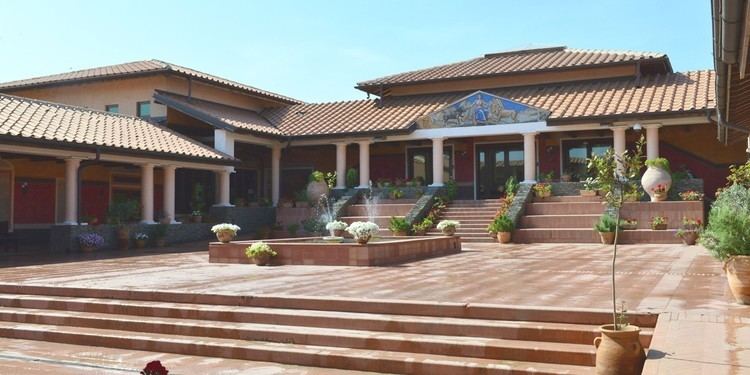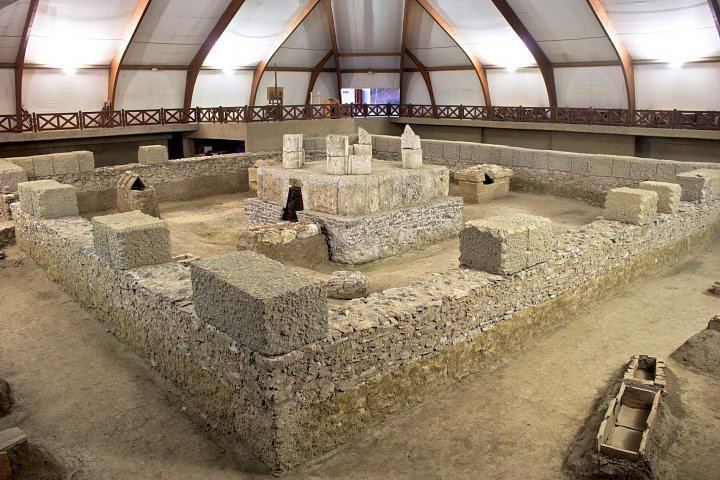Public access Yes Founded 1st century | ||
 | ||
Weather 19°C, Wind E at 11 km/h, 31% Humidity | ||
Guided tour viminacium ancient roman city serbia obilazak sa vodicem
Viminacium () was a major city (provincial capital) and military camp of the Roman province of Moesia (today's Serbia), and the capital of Moesia Superior (hence once Metropolitan seat, now a Latin titular see).
Contents
- Guided tour viminacium ancient roman city serbia obilazak sa vodicem
- Viminacium ancient roman city serbia viminacium starinski rimski grad srbija photo tour
- History
- Ecclesiastical history
- Titular see
- Location and excavation
- Archeological site
- Domus scientiarum Viminacium
- References

The site is located 12 km (7.5 mi) from the modern town of Kostolac in Eastern Serbia. The city dates back to the 1st century AD, and at its peak it is believed to have had 40,000 inhabitants, making it one of the biggest cities of that time. It lies on the Roman road Via Militaris. Viminacium was devastated by Huns in the 5th century, but was later rebuilt by Justinian. It was completely destroyed with the arrival of Slavs in the 6th century. Today, the archaeological site occupies a total of 450 hectares (1,100 acres), and contains remains of temples, streets, squares, amphitheatres, palaces, hippodromes and Roman baths.

Viminacium ancient roman city serbia viminacium starinski rimski grad srbija photo tour
History

The remains of Viminacium, the capital of the Roman province of Moesia Superior, are located on territories of the villages of Stari Kostolac and Drmno, about 12 km from the town of Kostolac and about 90 miles southeast of Belgrade. Viminacium was one of the most important Roman cities and military camps in the period from 1st to 4th centuries. Its exceptional strategic importance was reflected both in the defense of the northern border of the Roman empire and in turn of communications and commercial transactions. No less appealing to the Romans was the hinterland of the Mlava river valley, which is rich in ore and grains. In Roman times, the town on the northern side of relying directly on the branch of the Danube, while the western side, touching the walls Mlava rivers. Only in the later period, Viminacium spread to the left bank of Mlava. Thanks to the location, land and waterways, Viminacium represented one of those areas where the encounter of cultures between East and West was inevitable. Although these roads were the primary military and strategic function, they are taking place throughout antiquity very lively traffic and certainly contributed to the very Viminacium become prosperous and an important trading and business headquarters. In Viminacium, Roman legion VII Claudia was stationed, and a nearby civilian settlement emerged from the military camp. In 117 during the reign of Hadrian it received city status. In the camp, 6.000 soldiers were stationed, and 30-40.000 lived nearby. In the first half of then the 3rd century the city was in full development, as evidenced by the fact that at that time it acquired the status of a Roman colony, and the right to coin local money. Here, in 196, Septimius Severus declared his son Caracalla as successor with the status of "Caesar". In the mausoleum and the excavated tombs, the Roman emperor Hostilian, who died in 251, was buried.

A legion may have been stationed here as early as Augustus (27 BC-14 AD). In 33/34 AD a road was built, linking Viminacium and Ratiaria. Claudius (41-54) garrisoned Viminacium, Oescus and Novae as camps for the Moesian legions.
The first legion attested at Viminacium was the VII Claudia that came from Dalmatia in 52 AD.

Emperor Trajan (98-117) was headquartered here during the Dacian Wars. It became a colonia with minting privilege in 239 AD during the rule of Gordian III (238-244) and housed the Legion VII and Legion IV.
Emperor Hostilian was the son of the emperor Decius, who was killed in the ambush near the ancient city of Abrutus located in present-day Bulgaria. According to the old manuscript, emperor Hostilian and his mother came to Viminacium to supervise the organization of defense of northern borders, but both of them died of the plague. Because of the distance and the fear of spreading the plague, he was buried with all honors in Viminacium.
Viminacium was the provincial capital of Moesia Superior. In the late spring of 293-294, Diocletian journeyed through his realm and he re-organized Viminacium as the capital of the new province of Moesia Superior Margensis. He registered that the people wrote in Latin, as opposed to Greek in the southern provinces. Viminacium was the base camp of Legio VII Claudia, and hosted for some time the IIII Flavia Felix. It had a Roman amphitheatre with room for 12,000 people.
In 382 the city was the meeting place between Theodosius and Gratian amidst the Gothic Wars.
Viminacium was destroyed in 441 by the Attila the Hun, but rebuilt by Justinian I. During Maurice's Balkan campaigns, Viminacium saw destruction by the Avars in 582 and a crushing defeat of Avar forces on the northern Danube bank in 599, destroying Avar reputation for invincibility.
Ecclesiastical history
As provincial capital of Moesia Prima, Viminacium also became a Metropolitan archbishopric, presumably from about 300 to circa 400.
The Serbian Orthodox Eparchy of Braničevo is considered the successor of both Viminacium and Horreum Margi.
Titular see
The archdiocese was nominally restored in 1925 as a Latin Catholic Metropolitan titular archbishopric Viminacium (Latin) / Viminacio (Curiate Italian)
It has had the following archiepiscopal incumbents:
Location and excavation
Viminacium is located in Stari Kostolac (Old Kostolac) a Serbian town on the Danube river, east of Belgrade. Viminacium is the location of the first archaeological excavation in Serbia, which started in 1882, by Mihailo Valtrović, an architect by profession and the first professor of archeology at the college in Belgrade. The only help he received was from twelve prisoners, because the state did not have enough resources to provide him with a better work force. His research was continued by Miloje Vasić, in the 1970s. It has intensified in the last ten years in the area of the Roman city of the Roman legionary camps and cemeteries. Many studies suggest that the military camp at Viminacium had a rectangular plan, measuring 442 x 385 meters, and that is not far from its western wall of civilian settlement in an area of approximately 72 acres. The Legionary camp in Viminacium is now in an area of arable land, so that Viminacium is easily accessible to researchers, but unfortunately also to robbers. The National Museum in Belgrade and Požarevac have 40,000 items found in Viminacium, of which over 700 are made of gold and silver. Among them are many objects that are rare and invaluable.
Researchers have discovered more than 13,500 graves. The tombstones and sarcophagi are often decorated with relief representations of scenes from mythology or daily life. We have found numerous grave masonry construction. Especially interesting are the frescoes of the 4th-century tombs. The Frescos of young women have high artistic value as examples of Roman art. During the excavation, an amphitheater was discovered, which with its 12,000 seats was one of the largest in the Balkans.
Archeological site
Domus scientiarum Viminacium
Domus scientiarum Viminacium is a new scientific, research and tourist center build on the edge of the Archaeological park. The Domus was built as a Roman villa with rooms and laboratories grouped around several atriums. Building facilitates an archaeological museum, scientific library, laboratories for processing archaeological finds, information center, conference rooms, restaurant with dining hall and SPA center. There are also rooms prepared for researchers, students and visitors.
